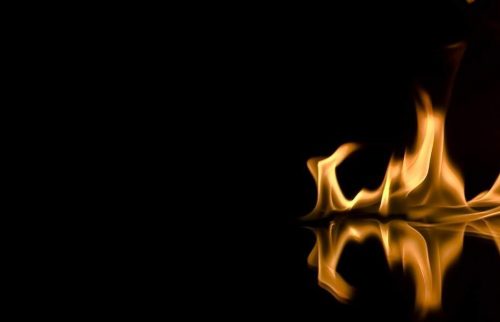We Cannot Suppress Every Fire with Water
Do You Know Where to Use Each Type of Extinguisher?
To fight and put out a fire when it begins, experts have created different types of extinguishers that we can use for different types of burning.
Do You Know Where to Use Each Type of Extinguisher?
To fight and put out a fire when it begins, experts have created different types of extinguishers that we can use for different types of burning.
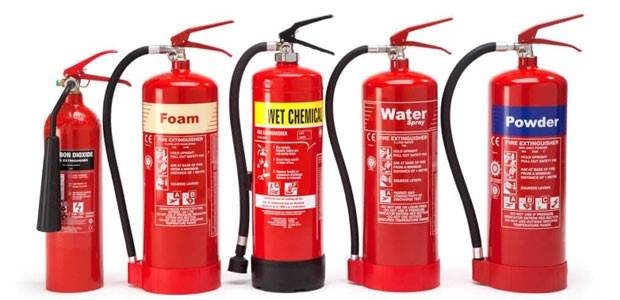
Do You Know How to Stop the Flames Caused by Cooking Oil?
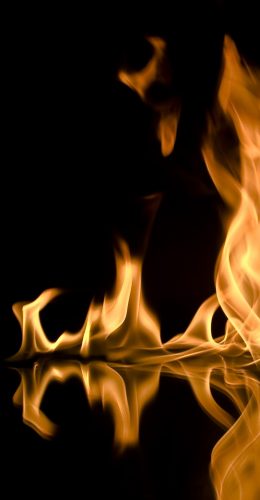
Many of us think that fire is just fire and the ways to put it out are the same. Many of us do not even believe that we cannot suppress everything with water. And using it in some fires can spread the fire more. So before taking any extinguisher to prevent the fire from growing, it is essential to understand what caused the flame and choose the extinguisher with the right content. Only then we can successfully suppress it, not letting the fire grow.
Do You Know How to Stop the Flames Caused by Cooking Oil?
Many of us think that fire is just fire and the ways to put it out are the same. Many of us do not even believe that we cannot suppress everything with water. And using it in some fires can spread the fire more. So before taking any extinguisher to prevent the fire from growing, it is essential to understand what caused the flame and choose the extinguisher with the right content. Only then we can successfully suppress it, not letting the fire grow.
Type of Fires
Specialists have been classified into A, B, C, D, F classes and separated electrical fires into a different category:
Class A fires are fires caused by organic solids. For example, paper, wood, cloth, rubber, and many plastics.
Class B fires include flammable liquids such as petrol and spirits. Class B fires do not involve alcohol or cooking oil.
Class C fires – This group are burning flammable gasses such as propane, butane, and methane. These types of fires are hazardous because they are incredibly explosive.
Class D fires refer to fires caused by flammable metals, such as aluminium, magnesium, titanium, lithium, sodium, etc. These class fires are not easy to put out because they can generate substantial damages.
Class F fires are produced by the kindling of cooking oils and fats. For example, they are cooking oil, lard, butter, etc. Usually, this kind of fire happens when the flashpoint is approximately 315 °c. Class F fires can spread very fast.
Electrical fires – For this class of fires, specialists have not given a whole class. Also, they have not put the symbol E. Instead, they set the lighting symbol. The reason for this is probably because electrical fires can occur from different things. According to the information of www.firesafe.org.uk: “After all, it is not the electricity burning but surrounding material that has been set alight by the electric current.”
These types of fires can be caused by electrical equipment such as computers, printers, photocopiers, machines, etc.
To someone who faces a fire caused by such an electrical device, the experts advise that the first thing should be switching the equipment off. An also, they add that: “It must be remembered that certain electrical apparatus maintains a lethal charge for some time after they have been switched off.”
Specialists have been classified into A, B, C, D, F classes and separated electrical fires into a different category:
Class A fires are fires caused by organic solids. For example, paper, wood, cloth, rubber, and many plastics.
Class B fires include flammable liquids such as petrol and spirits. Class B fires do not involve alcohol or cooking oil.
Class C fires – This group are burning flammable gasses such as propane, butane, and methane. These types of fires are hazardous because they are incredibly explosive.
Class D fires refer to fires caused by flammable metals, such as aluminium, magnesium, titanium, lithium, sodium, etc. These class fires are not easy to put out because they can generate substantial damages.
Class F fires are produced by the kindling of cooking oils and fats. For example, they are cooking oil, lard, butter, etc. Usually, this kind of fire happens when the flashpoint is approximately 315 °c. Class F fires can spread very fast.
Electrical fires – For this class of fires, specialists have not given a whole class. Also, they have not put the symbol E. Instead, they set the lighting symbol. The reason for this is probably because electrical fires can occur from different things. According to the information of www.firesafe.org.uk: “After all, it is not the electricity burning but surrounding material that has been set alight by the electric current.”
These types of fires can be caused by electrical equipment such as computers, printers, photocopiers, machines, etc.
To someone who faces a fire caused by such an electrical device, the experts advise that the first thing should be switching the equipment off. An also, they add that: “It must be remembered that certain electrical apparatus maintains a lethal charge for some time after they have been switched off.”



Type of Extinguishers
On the market, the types of portable extinguishers we can use in case of fire in our workplace or at home are:
– water extinguisher
– water spray extinguisher (water with additive)
– foam extinguisher
– carbon dioxide extinguisher
– powder extinguisher (multi-purpose)
– dry powder extinguisher (special powder)
– wet chemical extinguisher
– water mist extinguisher (de-Ionised water)
All above extinguishers have an indication colour on them. For example, all kinds of water extinguishers are coloured red. The rest of these fire equipment are also coloured red, but they have a second colour showing what substance is inside them.
On the market, there are also extinguishers such as fire blankets, hose reels and fire buckets.
For example, fire blankets are suitable for small pan fires and, if a person’s clothes are on fire, we can wrap them with a fire blanket. But to be able to extinguish the fire, it must cover the fire entirely.
Hose reel and fire bucket are suitable only for fires from Class A. It is dangerous to use them on burning oils or fats or an electrical device.
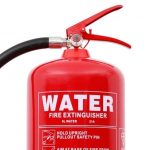

Water and Water spray extinguishers
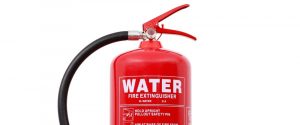

Both of these extinguishers are coloured signal red. They are suitable just for putting out fires from Class A.
They are not ideal for other types of fires. For example, using these extinguishers on burning fats, oil, or electrical devices also can be dangerous.
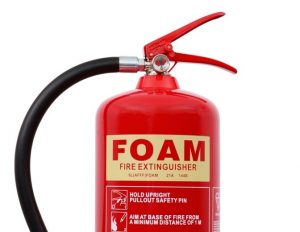
Foam (AFFF) extinguisher

Coloured red with a cream decoration over the instructions, the Foam (AFFF) extinguisher can be used to put out:
– Class A (organic solids – paper wood, etc.)
– Class B (flammable liquids – grease, paint, petrol, oil, etc. but not suitable for using on-chip or fat pan fires)
When using this tool, we must be careful in case of fires involving liquids. Experts recommend not directing the jet from the fire extinguisher directly into the liquid.
Carbon Dioxide extinguisher
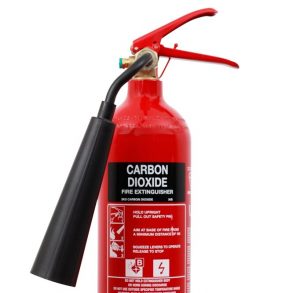
The Carbon Dioxide extinguisher is red coloured with a black section showing the type of this fire equipment. This kind of extinguisher is best for putting out:
– Class B (flammable liquids – grease, paint, petrol, oil, etc. but not suitable for using on-chip or fat pan fires)
– and live electrical fires
Although this tool is the most effective extinguisher on live electrical equipment, we must be careful when using it on small premises because CO2 gas is poisonous and can kill when ingesting high concentrations.
There is a risk that the fire will ignite again. Because this kind of extinguisher does not cool the fire enough, therefore, we must be careful not to leave the extinguished fire unattended until we are sure it is completely eradicated.
We must use only CO2 extinguishers with frost-free horns. Because when using this extinguisher, the gas coming from inside it is freezing. It is dangerous because it may freeze the hand holding the horn.
To not suffer later, we must train our employees how to use this fire extinguisher at all costs.

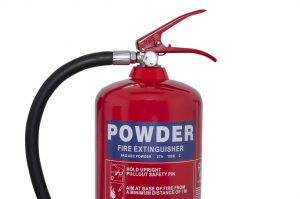
Dry Powder (multi-purpose) extinguisher

Coloured red with a blue rectangle in front, Dry Powder (multi-purpose) extinguisher can be used for fires from classes:
– Class A (organic solids – paper wood, etc.)
– Class B (flammable liquids – grease, petrol, oil, etc. but not suitable for using on-chip or fat pan fires)
– Class C (fires caused by flammable gasses)
– and electrical fires
Although this type of fire extinguisher has a fast knockdown, it is not very good at cooling the fire; There is a risk that the fire will ignite again. Therefore, we must be careful not to leave the extinguished fire unattended until we are sure it is completely eradicated.
The powder has a bad point, but this type of extinguisher.
This type of fire extinguisher can be dangerous to health if inhaled and can impair people’s vision if used indoors. Therefore, we must be cautious when using them.
Dry Powder extinguisher (Special Powders)
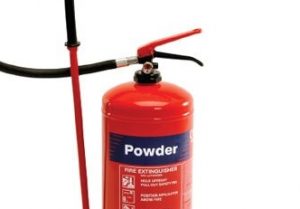
The Dry Powder extinguisher (Special Powders) is designed to deal with class D fires. These are fires caused by metals such as lithium, sodium, magnesium, etc. These kinds of fires can reach excessive temperatures up to 4700 ° C.
The contents inside these fire extinguishers can be graphite, copper, and sodium chloride. Like sodium chloride, it is not recommended to use for fires involving lithium.

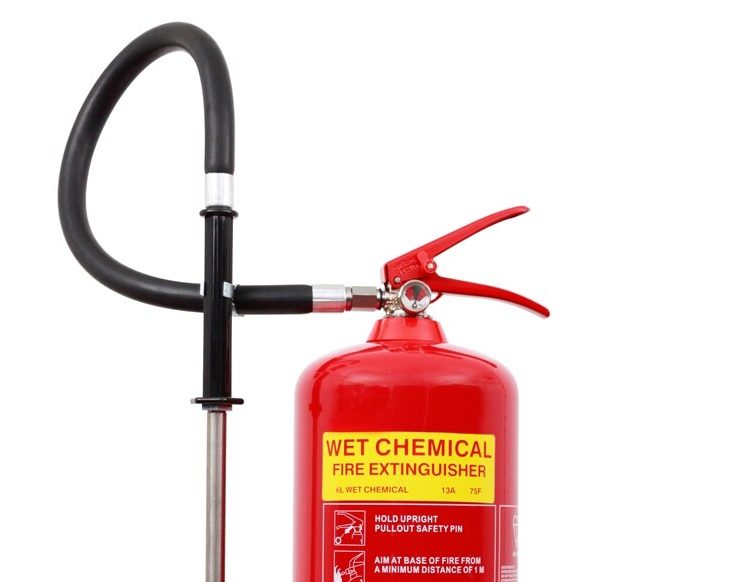
Wet Chemical Fire extinguisher

Coloured in red with a yellow rectangle on the front, the Wet Chemical Fire extinguisher is the only one most suitable for Class F fires (cooking oils, fats, oil, etc.)
The unique solution in this type of fire extinguishers can prevent and suffocate burning fat without any problems.
We can use this type of fire extinguisher to extinguish fires from:
– Class F (cooking oils and fats)
– Class A (organic solids – paper wood, etc.)
Although some manufacturers have created a wet chemical extinguisher with a B rating that can be used for Class B fires, their use is not recommended.
Water Mist extinguisher (De-Ionised Water)
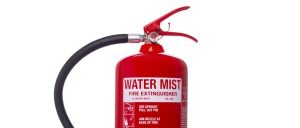
In this type of extinguisher, the water turns into microscopic particles in the supersonic nozzle. Thankfully to this working system, we can use this equipment in many classes of fires. We can blow out:
– Class A (organic solids – paper wood, etc.)
– Class B (flammable liquids – grease, petrol, oil, etc. but not suitable for using on-chip or fat pan fires)
– Class C (fires caused by flammable gasses)
– and small amounts of burning fats
On the market, we can also find models filled with de-ionised water. And if they are tested with a dielectric test to 35k Volts, we can use them for electrical fires up to 1000 Volts but keeping a safe distance of 1 metre.
We certainly cannot use a Water Mist extinguisher (De-Ionised Water) for deep fat fires or Grade D (burning metal swarf) fires.
Our experts believe that the use of this fire extinguisher by an incompetent person can be dangerous. Because of this, they do not recommend it.
The other disadvantage of this type of fire extinguisher is that its price is very high.
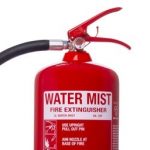
Maintenance
All Fire extinguishers must always be in working order because we never know precisely when to need these silent treasures. Therefore, every business must check once every month whether the fire extinguishers are in good condition.
For example, check if there is any damage to the fire extinguisher, make sure the tamper tag is still on the pin. And ensure the gauge is still in the green and the extinguisher is still in the designated position on the wall-mounted hook or stands provided.
If you do not know how to do your monthly checks, you can ask a competent person for help. Usually, our committed engineers show you how to do this can on first meeting or point of service.
Fire extinguishers that are unable to be used must be replaced immediately with new ones.
All fire extinguishers must be serviced once a year following BS 5306 by a competent person who holds certificates in this regard.

